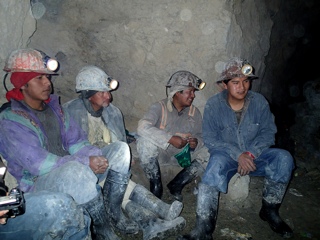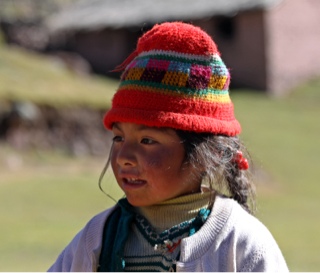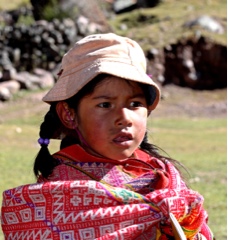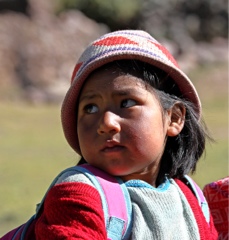Tuesday 21 May 2013
La Paz- Bolivia
Having crossed the border, the quickest yet, we are now in Bolivia and heading for Copacabana still on Lake Titicaca. A typical border town it is full of restaurants, tourist shops, cafes and of course lots of backpackers. We are still at 3800 m and the last week of exertion and pushing your body to the limit, climbing at altitude, has lowered the bodies defences and quite a few of us have come down with either a sickness or diarrhoea bug so although there are local walks and trips out to the islands to visit more Inca ruins I decide to hang out locally, rest up and recover ready for more strenuous activities to come.
Fully recovered, but still puffing after any exertion, we head to La Paz. We travel through an impressive scenic route through the Cordillera Real on one side and the lake shoreline on the other. We crossed the lake by ferry and barge across the Estrecho de Tiquina ( Tiquina Straits)
Ithaca looking pretty impressive perched on a wooden barge until it reached the middle and was swaying quite a bit, Rogan poised for a swim. We travelled separately in a wooden motor boat. Safely across we continue driving to La Paz, 3660 m, with snowy Mt Illimani (6402m) in the background. A massive sprawling city La Ciudaad de Nuestra Señora de La Paz ( the City of Our Lady of Peace ) was founded and named on October 20 1548 by a Spaniard called Captain Alonzo de Mendoza. The Spaniards loved shiny things and this was no different, the gold mines being seized pretty quickly and Cpt Mendoza installed as the city's first mayor. Despite its name La Paz has seen much violence in its history. Since Bolivian independence in 1825 the republic has seen over 190 changes of leadership. A high mortality rate accompanied high office, the job of president came with a short life expectancy. As recently as 1946 the then president Gualberto Villarroel was publicly hanged.
Now a bustling city we are staying at the Milton Hotel, right in the thick of it. Markets all around we spend two days exploring the side streets finding the Witches market with all manner of potions for every ailment, fruit and veg markets, tourist shops, museums, the gold museum in particular, church's and even time out for a game at the bowling alley. A bustling city it was a great couple of days again photographing locals about their business.
Needless to say another adrenaline boost was required so the Death Road Awaits, blog to follow.
Adios
Tony x
1-3. Ithaca leaving port
4-5. Ladies selling a few bits at the port
6-10. Shots around town
11-13. Street sellers
14. Dodge bus, bygone era
15-16. Witches market, foetus, frogs and god knows what else.
17. Streets full of tourist gifts.
Potosi - Bolivia
Left Le Paz en route to Potosi making good time but hit a village with a taxi strike and got stuck for 6 hours. Not being able to make up the time we bushcamped in an old quarry, waking to freezing cold conditions and ice on the tents. It was another early start, another amazing drive through incredible canyons, spectacular scenery, it was beautiful. Made good time and got settled into the hotel. Geoff and I decided our main activity here was to visit one of the cooperative silver mines and witness the working conditions which haven't changed for hundreds of years.
At 4070m Potosi was founded in 1545 with its Cerro Rico, a "Rich Hill" full of silver. During the boom years it became the largest and wealthiest city of the Americas. The amount of silver extracted is up for debate but one boast is that the Spanish could have constructed a silver bridge to Spain and still had silver left to carry across it. However the conditions under which the ore was extracted were abysmal and nothing much has changed in today's climate, it is dreadful. It is estimated that in over three centuries of colonial rule, 1545 - 1825, as many as eight million Africans and indigenous Bolivians died from the appalling conditions. Temperatures underground range from below freezing to above 115*c. The miners, exposed to all sorts of noxious chemicals and gases, normally die of silicosis pneumonia within 10 - 15 years. Since these cooperative mines are owned by the miners themselves they must produce to make a meagre living.
We were left under no illusion the danger these miners are under as they mine by hand and dynamite and are warned again of the shocking conditions.
We were prepared by our guides at our hostel with leggings, jackets, boots and a miners lamp. First stop the miners market to collect a few gifts of cigarettes, alcohol, juice and coco leaves. It became evident the way in which the miners cope was to constantly chew the coco leaves, drink 96% alcohol and work in a trance like state. We bought these items and unbelievably I also bought a stick of dynamite, a detonator, a fuse and some ammonium nitrate prill ( booster to make it more powerful ) all for £2.00 and put them in my rucksack and walked around town for an hour or so. I couldn't get my head around the fact I'd just bought these items from a small shop and I could have had as much as I wanted. By the time we got to the mines our guides were pretty red faced, both with large wadges of coco leaves packed into their cheeks. From the outset it looked a pretty desolate place and hardship was evident all around. The toilets were pointed out but no need to use them as they were full !!! not pleasant. Split into two groups we entered a small hole in the mountain side and ventured deep within in a permanent semi crouched position. Dark, tight tunnels twisting and turning, held up with wooden pit props, several broken, we ventured deeper into the labyrinth of passages. Eventually completing a 180* turn at the same time as climbing upwards and squeezing through a hole we came to a dead end where four miners were working. The air was dusty, thin on oxygen and breathing was difficult. I had a dust mask on plus a neck scarf to cut out the excessive dust. The miners had nothing except big wads of coco leaves. We sat with them whilst they explained their work, rituals and life's in general. We drank with them out of respect and to toast their god Tata Kaj'chu. I handed over my gifts and one of the miners proceeded to make the device used to blow the rock right in front of us. Having cut the dynamite in half he then attached the fuse to the detonator by crimping it (biting it) with his teeth. Now I've seen pictures of someone doing that when the detonator went off, not pleasant, so I did wince at this point. All made up using the alcohol container they placed it in a ready made hole and lit the fuse. We departed along a dead end tunnel around the corner and counted down. BOOM !! And a pressure wave went through you, the rocks were falling followed by a massive dust cloud.
We again chatted and returned to the blast site to see the effect of half a stick of dynamite. All that remained was a pile of rock and a shred of fuse.
All in all this was an incredible insight into the lives of the Potosi miners, the hardships, the dreadful working conditions, what they deal with on a daily basis and how they cope. A fascinating insight, an amazing experience which I personally wouldn't do again but an experience nevertheless. What another incredible day which wasn't to be missed.
Adios amigos
Tony x
At 4070m Potosi was founded in 1545 with its Cerro Rico, a "Rich Hill" full of silver. During the boom years it became the largest and wealthiest city of the Americas. The amount of silver extracted is up for debate but one boast is that the Spanish could have constructed a silver bridge to Spain and still had silver left to carry across it. However the conditions under which the ore was extracted were abysmal and nothing much has changed in today's climate, it is dreadful. It is estimated that in over three centuries of colonial rule, 1545 - 1825, as many as eight million Africans and indigenous Bolivians died from the appalling conditions. Temperatures underground range from below freezing to above 115*c. The miners, exposed to all sorts of noxious chemicals and gases, normally die of silicosis pneumonia within 10 - 15 years. Since these cooperative mines are owned by the miners themselves they must produce to make a meagre living.
We were left under no illusion the danger these miners are under as they mine by hand and dynamite and are warned again of the shocking conditions.
We were prepared by our guides at our hostel with leggings, jackets, boots and a miners lamp. First stop the miners market to collect a few gifts of cigarettes, alcohol, juice and coco leaves. It became evident the way in which the miners cope was to constantly chew the coco leaves, drink 96% alcohol and work in a trance like state. We bought these items and unbelievably I also bought a stick of dynamite, a detonator, a fuse and some ammonium nitrate prill ( booster to make it more powerful ) all for £2.00 and put them in my rucksack and walked around town for an hour or so. I couldn't get my head around the fact I'd just bought these items from a small shop and I could have had as much as I wanted. By the time we got to the mines our guides were pretty red faced, both with large wadges of coco leaves packed into their cheeks. From the outset it looked a pretty desolate place and hardship was evident all around. The toilets were pointed out but no need to use them as they were full !!! not pleasant. Split into two groups we entered a small hole in the mountain side and ventured deep within in a permanent semi crouched position. Dark, tight tunnels twisting and turning, held up with wooden pit props, several broken, we ventured deeper into the labyrinth of passages. Eventually completing a 180* turn at the same time as climbing upwards and squeezing through a hole we came to a dead end where four miners were working. The air was dusty, thin on oxygen and breathing was difficult. I had a dust mask on plus a neck scarf to cut out the excessive dust. The miners had nothing except big wads of coco leaves. We sat with them whilst they explained their work, rituals and life's in general. We drank with them out of respect and to toast their god Tata Kaj'chu. I handed over my gifts and one of the miners proceeded to make the device used to blow the rock right in front of us. Having cut the dynamite in half he then attached the fuse to the detonator by crimping it (biting it) with his teeth. Now I've seen pictures of someone doing that when the detonator went off, not pleasant, so I did wince at this point. All made up using the alcohol container they placed it in a ready made hole and lit the fuse. We departed along a dead end tunnel around the corner and counted down. BOOM !! And a pressure wave went through you, the rocks were falling followed by a massive dust cloud.
We again chatted and returned to the blast site to see the effect of half a stick of dynamite. All that remained was a pile of rock and a shred of fuse.
All in all this was an incredible insight into the lives of the Potosi miners, the hardships, the dreadful working conditions, what they deal with on a daily basis and how they cope. A fascinating insight, an amazing experience which I personally wouldn't do again but an experience nevertheless. What another incredible day which wasn't to be missed.
Adios amigos
Tony x
Saturday 18 May 2013
Lares Valley Trek - Peru
Last page of stunning scenery and the people we met along the way.
1-4. Snow capped mountains, breath taking
5. Local lady tending the sheep
6-7. A couple of likely lads
8. Another little chap we met along the way
9. The Odyssey trek group
10-16. Some beautiful local kids attending school in middle of mountains.
17-20. Coming to the end of the trek, amazing.
21. At the end of the trek two lovely young girls came out to see us and I chatted in broken Spanish with their Mum.
A great end to a wonderful trip.
Adios
Tony x
1-4. Snow capped mountains, breath taking
5. Local lady tending the sheep
6-7. A couple of likely lads
8. Another little chap we met along the way
9. The Odyssey trek group
10-16. Some beautiful local kids attending school in middle of mountains.
17-20. Coming to the end of the trek, amazing.
21. At the end of the trek two lovely young girls came out to see us and I chatted in broken Spanish with their Mum.
A great end to a wonderful trip.
Adios
Tony x
Subscribe to:
Posts (Atom)
































































